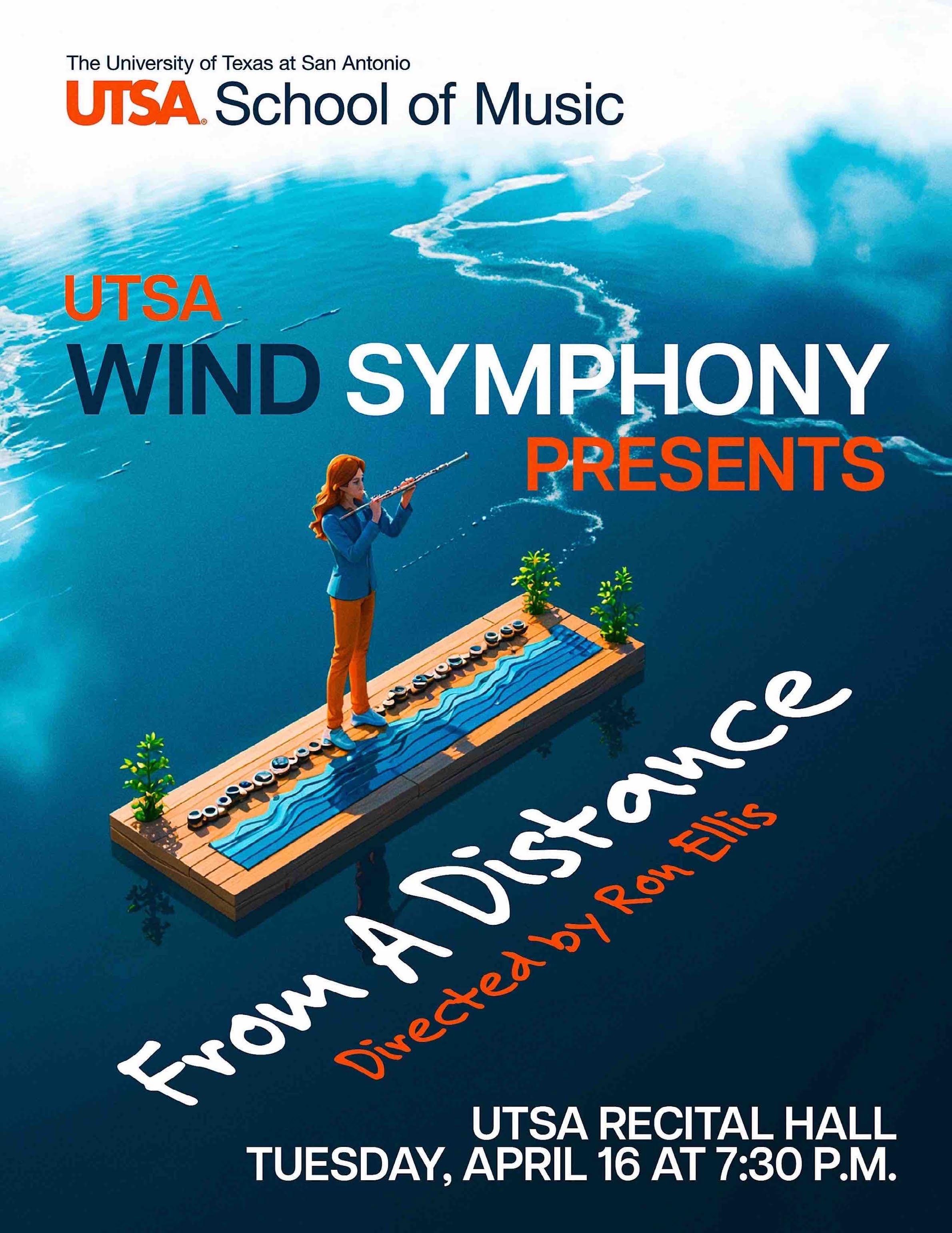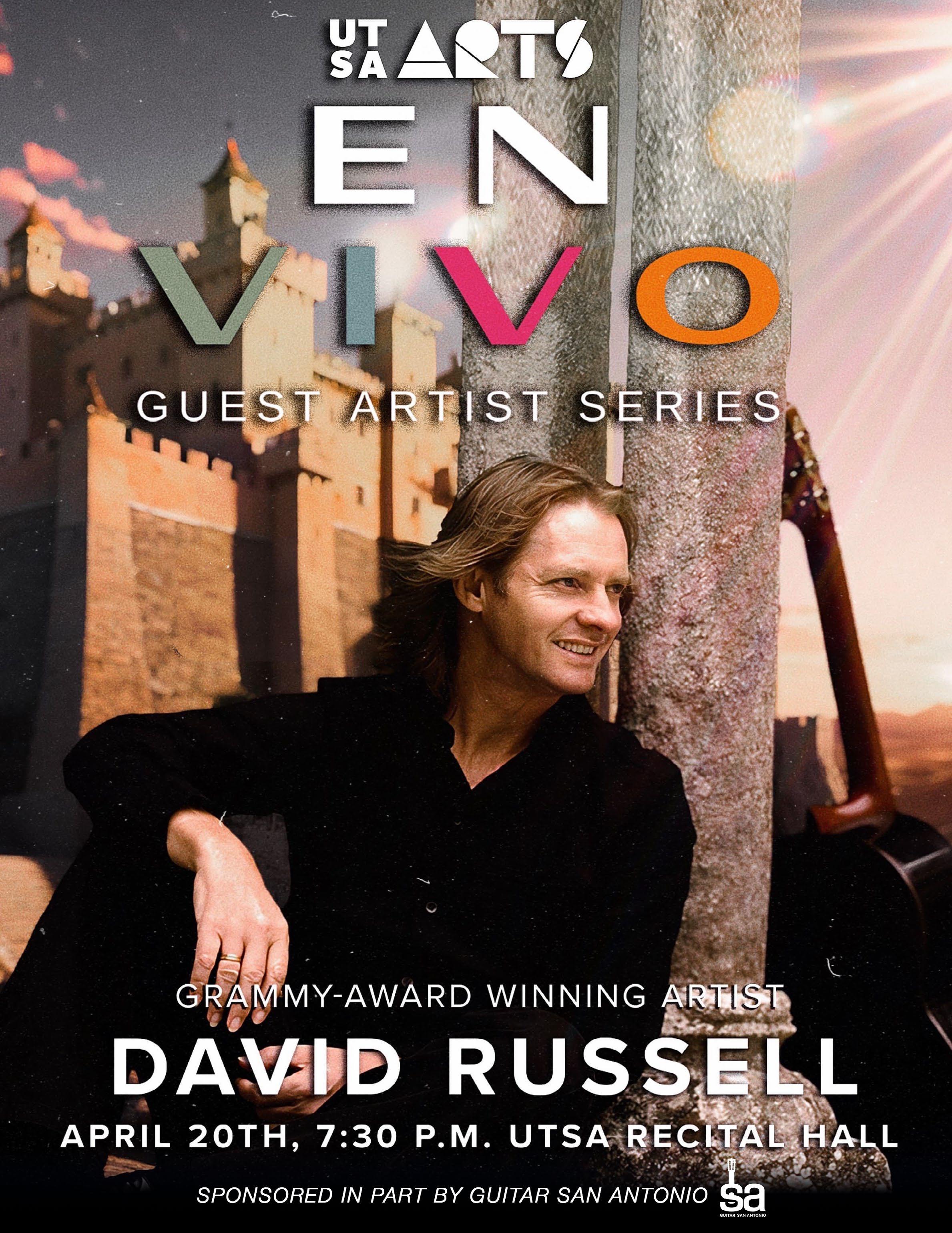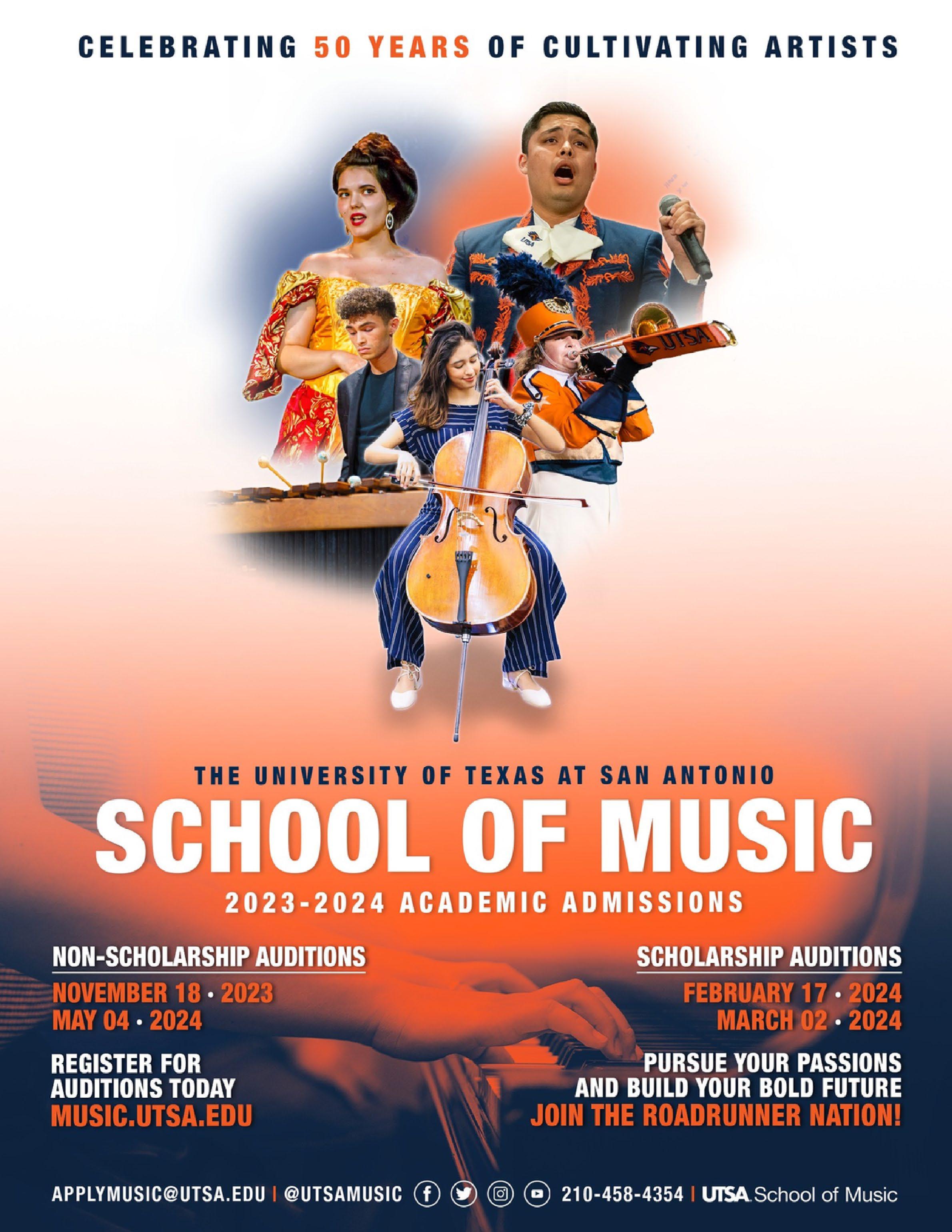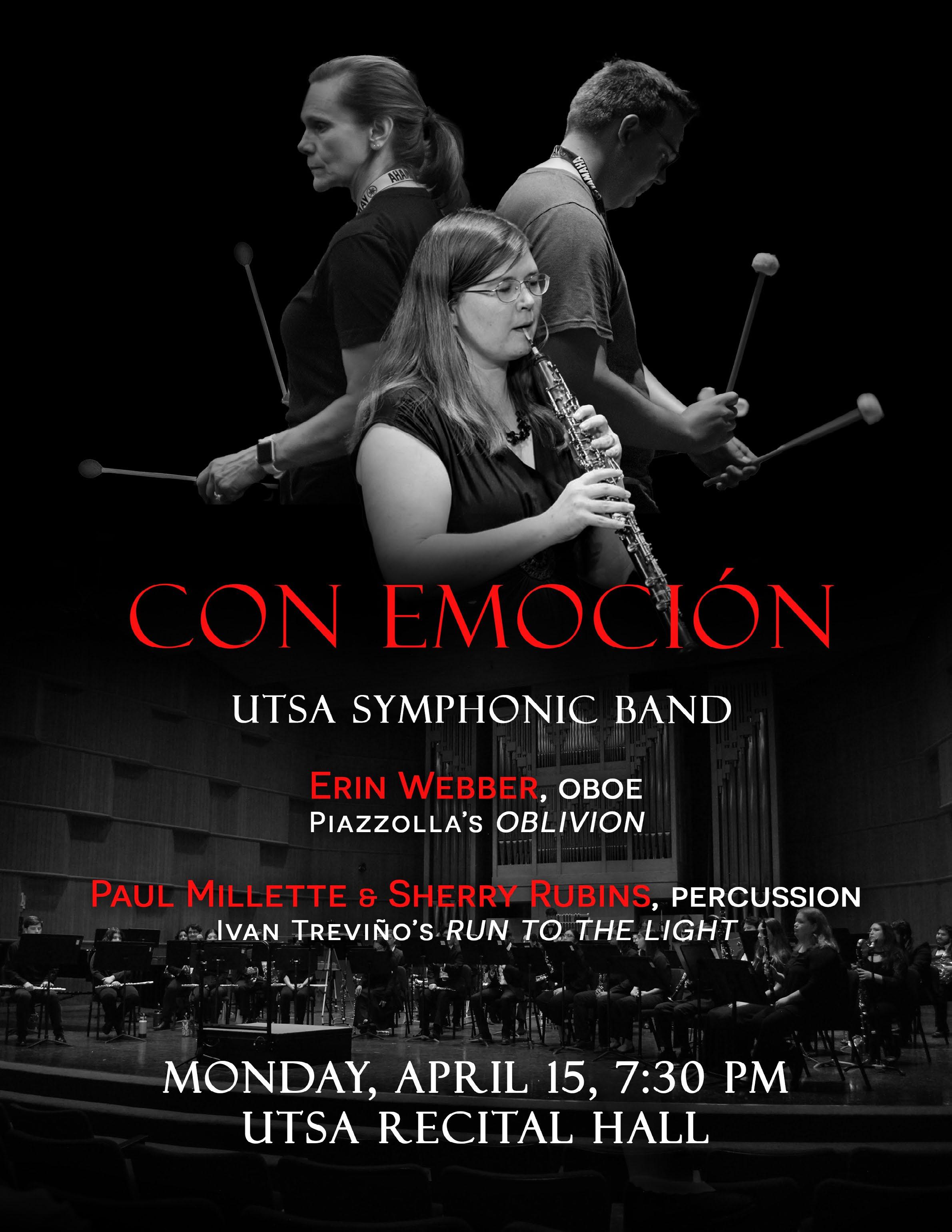University of Texas at San Antonio Symphonic Band
Music Education (Houston, TX)
Lauren Garcia
Music Education (San Antonio, TX)
Marisa Knopf
Music Education (San Antonio, TX)
Kylie Nix
Music Education (Cedar Creek, TX)
Andrew Przybyla
Music Education (San Antonio, TX)
O b o e
Makayla Aguilar
Music Education (San Antonio, TX)
Logan Odom
Music Education (Kyle, TX)
C l a r i n e t
Joshua Avalos
Music Education (San Antonio, TX)
Orlando Barron
Music Education (Boerne, TX)
Connor Boyson
Music Education (Helotes, TX)
Sarah Hamm
Music Education (Stafford, VA)
Jaden Hernandez
Music Composition (San Antonio, TX)
DeShona Jernigan
Music (Marshall, TX)
A l t o S a x o p h o n e
Sam Bowman*
Music Education (Austin, TX)
Esau Hernandez
Music Education (Cedar Creek, TX)
Bryson Vincent
Music Education (Georgetown, TX)
T e n o r S a x o p h o n e
Richard Ytuarte
Music Education (Converse, TX)
B a r i t o n e S a x o p h o n e
Rachel Blakeney
Music Education (Harker Heights, TX)
H o r n
James Gonzales
Music Education (San Antonio, TX)
Francis Maille
Music Education (San Antonio, TX)
Myrna Ramirez
Music Education (Lufkin, TX)
David Valdez
Music Education (San Antonio, TX)
Scott West
Music Education (Helotes, TX)
T r u m p e t
Kenedy Cardenas
Music Education (San Antonio, TX)
Xavier Contreras
Music Education (San Antonio, TX)
Alissa Esper
Communications (Boerne, TX)
Normandy Morzynski
Physics (Montgomery, TX)
Yoshi Murillo
Special Education (Universal City, TX)
Daniel Vazquez
Music Education (Los Angeles, CA)
T r o m b o n e
Molly Busch
Mechanical Engineering (Austin, TX)
Brandin Castillo
Music Education (San Antonio, TX)
Caroline Foster
Music Education (San Antonio, TX)
B a s s T r o m b o n e
Thomas Gonzales-Mata
Music Education (Corpus Christi, TX)
E u p h o n i u m
Finley Farrar
Music Education (San Antonio, TX)
Michael Hernandez
Music Education (Kyle, TX)
Aidan Ramos
Music Composition (San Antonio, TX)
T u b a
Frankie Rodriguez
Music Education (San Antonio, TX)
Christian Tapia*
Music Education (San Augustine, TX)
Mikelis Teteris (SSG, USA. Ret.)
Music Education (Wildomar, CA)
P e r c u s s i o n
Erin Faehnle
Music Education (Marble Falls, TX)
Adam Jackson
Music Education (San Antonio, TX)
Gabriel Leal
Music Marketing (San Antonio, TX)
Juan Martinez
Music Education (Laredo, TX)
Fernando Perez
Music Education (Weslaco, TX)
Ivan Ventura
Music Education (Laredo, TX)
P i a n o
Ethan Aguilar
Music Composition (Helotes, TX)
A s s i s t i n g M u s i c i a n s
Brendan Tsai, bassoon
Jared Worman, bassoon
Michael Summers, bass clarinet
Heri Ayma, double bass
B a n d S t a f f
Jordan Rodriguez, music librarian
Jared Worman, music librarian
Brandin Castillo, manager
Alissa Esper, manager
Caroline Foster, manager
DeShona Jernigan, manager
Logan Odom, manager
Aidan Ramos, manager
David Valdez, manager
Roster is listed alphabetically to emphasize the important contribution made by each musician.
* Denotes graduating/outgoing member
J o h n Z a r c o is Director of Instrumental Ensembles and Associate Professor of Music at the University of Texas at San Antonio. His responsibilities include conducting the UTSA Symphonic Band and University Band, in addition to teaching graduate and undergraduate courses in conducting, wind literature, and music education.
Prior to his appointment at UTSA, Dr. Zarco served as Director of Bands at Millersville University in Pennsylvania and as a public school instrumental music teacher at Saratoga High School, in Saratoga, California. He received a D.M.A. in conducting from the University of Minnesota as well as B.M. (music education) and M.M. (conducting) degrees from California State University, Sacramento. Dr. Zarco has been awarded honorary memberships in the national organizations of Pi Kappa Lambda, Sigma Alpha Iota, Kappa Kappa Psi, Tau Beta Sigma, and Phi Mu Alpha Sinfonia. His book, Rehearsing the Band, Volume 3 is published by Meredith Music Publications and is distributed by Hal Leonard.
G u e s t A r t i s t s
E r i n W e b b e r holds the position of Assistant Professor of Practice at the University of Texas at San Antonio, where she leads a rapidly growing oboe studio and coaches the UTSA Wind Quintet. She also maintains a private studio and operates a thriving Etsy shop, Erin’s Oboe Reeds. Prof. Webber is an active free-lance musician in the San Antonio area, playing oboe and English horn regularly with the San Antonio Philharmonic, as well as regional ensembles such as Symphony of the Hills and Mid-Texas Symphony. She holds the position of principal oboe with Alamo City Symphony Viva and is a founding member of San Antonio Harmonie Ensemble. Most recently she began exploring baroque oboe and plays regularly with Sonido Barroco San Antonio. Prof. Webber collaborates regularly with fellow UTSA faculty on solo and chamber recitals. Invested in promoting new music for double reeds, she has joined a number of composition consortiums and in 2023 premiered Corpse Flower, a sonata for oboe and piano by Martin J. Van Klompenberg. She will be presenting a recital at the 2024 International Double Reed Society conference, giving the world premier of Van Klompenberg’s Feliformia for oboe and bassoon. She earned her Masters in Music Performance from Arizona State University, studying with Martin Schuring, and her Bachelors in Music Performance from Western Kentucky University, studying with Dr. Michele Fiala. She also spent several years mentoring with David Weber of Weber Reeds Inc. Prof. Webber’s composition for oboe, English horn and piano, Overheard on a Saltmarsh, is available through Trevco Music and can be heard on Michele Fiala’s CD Overheard. wuw
P a u l M i l l e t t e is a percussionist, composer, and educator based out of San Antonio, Texas. He currently serves as Assistant Professor of Practice in Percussion at the University of Texas at San Antonio, where he teaches applied percussion, percussion pedagogy, and percussion literature. He has been invited to present clinics and masterclasses at universities throughout the United States and currently works with the percussion program at Harlan High School.
Prof. Millette’s recent professional engagements include performances with the San Antonio Philharmonic, United States Air Force Band of the West, Mid-Texas Symphony, and Public Theater of San Antonio. Recent recording credits include recording with the King’s Brass through Summit Records, the United States Air Force Band of the West, and Density 512 on the Toccata Classics label. He has recently
C o n d u c t o r
performed at conferences such as the North American Saxophone Alliance Biennial Conference, the International Trumpet Guild Conference, and the National Conference on Percussion Pedagogy.
An active composer, Prof. Millette’s music is published through Tapspace, C. Alan, and Wildlight Publications. His music has been performed at notable institutions such as Indiana University, Florida State University, the University of Texas at Austin, the University of North Texas, and the Percussive Arts Society International Convention. He received his BM in Percussion Performance from the University of North Dakota, his MM in Percussion Performance from the Indiana University Jacobs School of Music, and is currently pursuing a DMA in Percussion Performance at Texas Tech University. wuw
S h e r r y R u b i n s is Professor of Practice and coordinator of the percussion program at the University of Texas at San Antonio. Mrs. Rubins directs the percussion and steel drum ensembles and teaches undergraduate and graduate percussion majors. She is Principal Timpanist and Personnel Manager of the Mid-Texas Symphony, and Principal Timpanist with the Victoria Bach Festival. For over 35 years, Mrs. Rubins performed as a substitute musician with the San Antonio Symphony. She is now personnel manager and assistant principal percussionist with the newly formed San Antonio Philharmonic.
Mrs. Rubins received her Bachelor of Music Education degree from Western Illinois University. She was a graduate assistant at Baylor University, and she finished her Master of Music degree in performance at the University of Texas at San Antonio.
A busy freelance percussionist, Mrs. Rubins has contracted and played for numerous touring shows including A Tribute to Prince, Weird Al, and Hugh Jackman. She has presented clinics and performances throughout the south Texas area, the Texas Music Educators Association, the Texas Bandmasters Association Convention, the Music for All National Percussion Symposium in Indianapolis, and the Percussive Arts Society International Convention.
Mrs. Rubins is an artist/educational clinician for the Zildjian/Vic Firth Company, Remo Percussion, and the Yamaha Corporation. She has been featured on the Zildjian, Texas Music Educators, and Vic Firth web sites. Mrs. Rubins is an active long-time member of the Percussive Arts Society (PAS) where she serves as a member of the Board of Advisors. In the past she also served as Vice-President of the Texas Chapter of PAS.
Dr. Tracy Cowden, Director, School of Music
Dr. Stacey Davis, Acting Director, School of Music
Dr. Kasandra Keeling, Associate Director, School of Music
Naomy Ybarra, Administrative Services Officer 1
Steven Hill, Administrative Associate
Wesley Penix, Senior Events Manager
Rolando Ramon, Marketing Coordinator
Mr. Donald Marchand, Music Program Specialist, UTSA Bands
Prof. Ron Ellis, Director of Bands
S p e c i a l t h a n k s t o t h e f o l l o w i n g f o r t h e i r o n g o i n g s u p p o r t a n d d e d i c a t i o n t o t h e U T S A B a n d s :
Prof. Hector Garcia, Assistant Director of Athletic Bands
Prof. Sherry Rubins and Prof. Paul Millette, Percussion Area Faculty
Dr. Rachel Woolf and Dr. Oswaldo Zapata, Woodwind and Brass Area Coordinators
Prof. Troy Peters, Director of Orchestras
Dr. Yoojin Muhn, Director of Choral Activities
Dr. Jordan Boyd, Assistant Director of Choral Activities
UTSA School of Music Faculty
Jordan Rodriguez and Jared Worman, School of Music Librarians
UTSA Bands Managers
P r o g r a m N o t e s
Compiled and Edited by John Zarco
Alfred Reed began his musical studies at age ten on trumpet, and by high school age he was performing professionally in the Catskills at resort hotels. He served as musician and arranger during World War II in the 529th Army Air Force Band, for which he created more than 100 works, and following the war was a student of Vittorio Giannini at Juilliard. He was staff composer and arranger for both the National Broadcasting Corporation and the American Broadcasting Corporation. In 1953, Mr. Reed became conductor of the Baylor Symphony Orchestra at Baylor University in Waco, Texas, at the same time completing his academic work; he received his B.M. in 1955 and his M.M. in 1956. In 1966, he joined the faculty of the School of Music at the University of Miami, with a joint appointment in the Theory-Composition and Music Education departments. With over 250 published works for concert band, wind ensemble, orchestra, chorus, and various smaller chamber music groups, many of which have been on the required performance lists in this country for many years, Reed was one of the nation’s most prolific and frequently performed composers.
E l C a m i n o R e a l (literally "The Royal Road" or "The King's Highway") was commissioned by, and is dedicated to, the 581st Air Force Band (AFRES) and its commander, Lt. Col. Ray E. Toler. Composed during the latter half of 1984 and completed in early '85, it bears the subtitle "A Latin Fantasy."
The music is based on a series of chord progressions common to countless generations of Spanish flamenco (and other) guitarists, whose fiery style and brilliant playing have captivated millions of music lovers throughout the world. These progressions and the resulting key relationships have become practically synonymous with what we feel to be the true Spanish idiom. Together with the folk melodies they have underscored, in part derived by a procedure known to musicians as the "melodizing of harmony," they have created a vast body of what most people would consider authentic Spanish music.
The first section of the music is based upon the dance form known as the Jota, while the second, contrasting section is derived from the Fandango, but here altered considerably in both time and tempo from its usual form. Overall, the music follows a tradition three-part pattern: fast-slow-fast.
The first public performance of El Camino Real took place on April 15th, 1985, in Sarasota, Florida, with the 581st Air Force Band under the direction of Lt. Col. Ray E. Toler.
[Program note from windrep.org] wuw
Astor Piazzolla was an Argentine tango composer and bandoneón player. His compositional output revolutionized the traditional tango into a new style termed “nuevo tango,” incorporating elements from jazz and classical music. Piazzolla was born in Mar del Plata, Argentina in 1921 to Italian parents, Vicente Nonino Piazzolla and Asunta Manetti. Astor Piazzolla spent most of his childhood with his family in New York City, where he was exposed to both jazz and the music of JS Bach at an early age.
In 1953, Piazzolla entered his Buenos Aires Symphony in a composition contest, and won a grant from the French government to study in Paris with the legendary French composition teacher Nadia Boulanger. Piazzolla returned from New York to Argentina in 1955 and formed the Octeto Buenos Aires. As a virtuoso bandoneonist, Piazzolla regularly performed his own compositions with a variety of ensembles. In 1992, American music critic Stephen Holden described Piazzolla as "the world's foremost composer of tango music."
While living in Italy in the 1980s, Piazzolla composed O b l i v i o n as music for a film by Mario Bellochio, entitled Enrico IV. Oblivion is written in the style of a milonga, a song form that predates the tango. It has become one of Piazzolla’s most popular works, and has been adapted for performance by a variety of solo instruments
[Program note from The Atlanta Symphony Orchestra and The Carson City Symphony] wuw
Benjamin Horne earned his master's degree at the Jacobs School of Music at Indiana University and his bachelor’s at the Schwob School of Music at Columbus State University (GA) with degrees in music education, music performance, and a certificate in music composition. Horne studied composition with Dr. James Ogburn, Dr. Don Freund, and Dr. Sky Macklay. His works and arrangements have received many honors and have been performed around the world, including at the Latzsch Trombone Festival in Germany, as well as performances at other events such as the International Tuba and Euphoni um Conference and the International Trombone Festival. Mr. Horne has collaborated on works with several renowned classical artists such as Demondrae Thurman and Charles Vernon.
As an educator, Mr. Horne served as a middle and high school assistant band director at Holcomb Bridge Middle School and Centennial High School in Roswell, Georgia, where he also led the jazz program. Horne is also a part of the brass staff at the Sacramento Mandarins Drum and Bugle Corps. He has also worked as an instructor and clinician across the United States teaching sectionals, private lessons, masterclasses, and marching band at all levels from beginners to university students.
r is an arrangement of the traditional spiritual of the same name for wind band. This arrangement is inspired by a popular art song version by Henry Burleigh. His low baritone voice as well as renditions by singers such as Paul Robeson are the motivation for this version's use of solo tuba for the song's initial presentation. Other allusions to Burleigh can be found through the work.
Deep River for wind band opens with solos from various voices evocative of short testimonies before we begin the song. The low voice of the tuba then leads us in with the first verse as others join in. At the conclusion of the lyric "peace," an alto saxophone solo "crosses" us over into a new place where the song starts again, but livelier featuring the entire saxophone section. This arrangement is dedicated to Anthony Morris.
[Program note from windrep.org and the composer] wuw
Ivan Treviño is an American composer, percussionist, and rock drummer. He received a B M and M.M. from Eastman School of Music, where he went on to design and teach a course in music business before moving to Austin in 2014. Treviño is a songwriter and percussionist with Break of Reality, an international touring cello and percussion quartet. As a composer, Treviño’s music is regularly performed around the world and has become standard repertoire in the field of percussion. He is a multi-award winning recipient of the Percussive Arts Society’s International Composition Contest and has composed over 40 works for the percussion idiom, many of which were commissioned by leading performers and universities in the field. In addition to composing and performing, Treviño is an active educator who has presented educational clinics at hundreds of institutions around the world.
In the program notes to R u n t o t h e L i g h t , Treviño writes:
A newly hired band director at my high school had a diploma hanging up in his office.
“What’s that?” I asked.
“It’s from Eastman,” he said.
“What’s Eastman?” I asked again.
“It’s a music conservatory,” he said.
I left his office thinking to myself, “What’s a music conservatory?”
That was my junior year of high school, and that’s how foreign this whole classical music thing was to me. Fast forward one year later I auditioned at Eastman and got in. This was due in large part to this teacher, his guidance, and my own luck that he took a job teaching music in small town Victoria, Texas, where I lived. Thank you again, Mr. Mikula.
When I told my mom I got accepted, she didn’t congratulate me. Well, of course she did, but not right away. The first thing she said was, “How are we going to pay for it?” My parents didn’t go to college, but are hard- working, smart people who still make their living cutting hair. They did everything they could to make music part of my life. Paying for college, though, especially at a school like Eastman, was far beyond anything they had saved or
D e e p R i v e
planned for. My parents put together whatever funds they could and did what everyone does in Texas during a time of need: they organized a BBQ benefit. It’s a Go-Fund Me of sorts, but an in-person one with BBQ, beans, rice and all the fixings.
One of my dad’s regulars was a writer for the local paper and wrote a charming story about my parents, my opportunity to attend Eastman, and about the upcoming BBQ benefit. Local restaurants donated food, and my parents and an assembly line of volunteers served plates to friends, family and members of our community who showed up to give their support and enjoy a hot meal. There was even an auction with one of those fast-talking auctioneers helping the crowd bid on donated items.
My parents hosted this benefit for four summers, and each time, they raised $10,000 for my college tuition, with over 1,000 people attending each year. This is still incomprehensible to me. Meanwhile, Eastman provided me with a generous yearly scholarship to ease the cost of tuition, which helped greatly. My journey to Eastman was looking more and more possible, thanks in part to this scholarship, and of all things, BBQ. But we still weren’t quite there.
One day, Mary Lou Urban, an unassuming family friend of ours, walked into the barber shop to see my mom for her regularly scheduled perm. This time, Mrs. Urban came in holding a small envelope with my mom’s name on it. Inside was a gift: a personal check for $10,000. My mom cried, Mrs. Urban cried. But that’s not all. Each summer for four years, she gave my mom a check for this same amount. Mrs. Urban is no longer with us, but what she did for me and my family is unforgettable. My mom refers to her as my angel. I do too. Between the community’s support, Eastman’s scholarship, Mrs. Urban’s gifts, and my parent’s own hard work and sacrifice, I got to Eastman.
Twenty years later, I find myself at Eastman again, this time as a visiting teacher to step in for the one and only Michael Burritt, my former Eastman professor who is on a sabbatical leave. What an honor. I return with my beautiful wife, Amanda, who I met on Gibbs St. when we were both students. This music is dedicated to all of the supporters in my hometown community, Mr. Mikula, Mrs. Urban, my parents, and all of the people who helped me run to my light. I carry them with me, in my teaching, composing and performing, and I hope this spirit of joy and gratitude shines through in this music.
Run to the Light was written for Eastman School of Music’s Centennial Celebration. It was premiered by Eastman Wind Ensemble on Oct. 19, 2022. The piece is dedicated to a thousand or so very special people in Victoria, Texas.
[Program note from windrep.org and the composer] wuw
Karl Lawrence King was born February 21, 1891, in Paintersville, OH. He showed musical talent late in his childhood and began playing trombone in the Canton Marine Band. At the behest of his teacher, he took up the baritone and found it better suited to his skills. He never had any formal training in theory or composition, but became quite a capable
orchestrator. By the age of 17, he produced his first march; two years later he began playing baritone with the band of Robinson's Famous Circus. Within a few years, he became the ensemble's director. Starting in 1917, he eventually served in the same capacity for Barnum & Bailey's “Greatest Show on Earth.”
In 1920, King moved his family to Fort Dodge, IA, to serve as director of the Fort Dodge Military Band. He also supported the family with a publishing company he had earlier established. King served as bandmaster of the Fort Dodge band for 38 years, retiring in 1959. He continued to make guest appearances leading other bands into the 1960s. King’s compositional output includes approximately 300 works, most being marches.
C i r c u s D a y s is one of 13 gallops or marches that Karl King wrote, intended to be played at blazing speeds. As in the case of many circus-type marches, the intent is to provide energy and excitement to the performance, and bring a sense of joy and happiness to the listeners. In the score to the piece, King dedicates the march to Jerry Huffman, his close friend and trumpet player with the Sousa Band.
[Program note from windrep.org]
